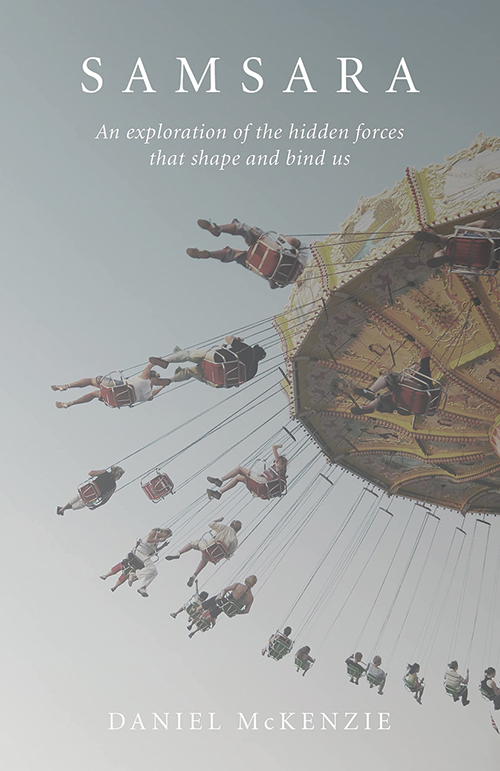
Samsara: An Exploration of the Hidden Forces That Shape and Bind Us
Reviewed by Max L. Carter
November 1, 2022
By Daniel McKenzie. Mantra Books, 2022. 112 pages. $12.95/paperback; $6.99/eBook.
A quick Internet search for the word “samsara” typically leads to the name of a business resource for increasing productivity or a variety of wines before it finally lands on a description of one of the central concepts in Eastern philosophy: usually explained as the constant cycle of birth, death, and rebirth. In this brief book by an author of several works on the ancient wisdom tradition of Vedanta, samsara is defined as a “negative psychological condition brought on by the misinterpretation of reality.” McKenzie then seeks to show the reader that the concept of samsara is more than a metaphor for the endless transmigration of the soul. Rather, it is a condition from which we’re all unconsciously trying to escape.
That condition is the set of stories in our lives that purportedly give us meaning but, instead, lead to frustration and lack of fulfillment. In short, the answer to that problem is to change the story.
The story that needs to be changed is that happiness lies in objects. Advertising, the author maintains, promotes that idea. Indeed, when we were raising our young children and allowed them a very limited amount of children’s programming on TV each day, we told them that commercials tried to get them to want things they didn’t need, and they should say “Boo, hiss!” when they came on. Invariably, we would hear the children shout out, “Boo, hiss!” as ads appeared and then hear them running to us saying, “Mommy, Daddy, I need such and such!”
Eastern philosophy as well as science, McKenzie writes, teach us that objects aren’t what they appear to be. He introduces the idea of “maya,” the illusion of reality, and compares it to the worldview presented by cable news networks and the profusion of conspiracy theories. Detachment is the answer, and better yet, not letting the chain of attachment begin in the first place. That extends to not confusing our own identity with our bodies but placing it with our True Self: that within us which is “aware” of the illusion around us.
To extricate ourselves from the false stories requires “best practices,” and the author draws on the wisdom of the sacred text of the Bhagavad Gita to offer such practices. Among its teachings, he cites following the physical, psychological, and moral laws of the universe: what Eastern tradition calls “dharma,” the natural order of things. In addition, proper action is called for, as well as mindfulness, meditation, and physical disciplines. “The remedy for samsara is right knowledge, plus right identification,” which McKenzie reduces to the “Four Ds” of discrimination (discerning between truth and falsehood), dispassion (detachment), discipline (practices that reveal the True Self), and desire (for liberation).
An epilogue and endnotes offer an interpretation of the author’s main thesis in “God-language” and give a helpful outline of terms, along with a sample meditation.
While McKenzie is not a Quaker—the book is not directed at a Quaker audience and the spiritual wisdom drawn upon is one historically different from Quakerism’s Christian roots—the parallels between the insights of this Eastern wisdom tradition and the central testimonies of Friends are many. The argument can be made that the “True Self” described in the Gita is not unlike “that Light which enlightens all people” in the Gospel of John, and that the Quaker practice of “centering down” is related to seeking that Self/Light. Seeing that Self/Light in others is the basis for an understanding of equality; avoiding falsehoods is at the core of seeking integrity; recognizing that war and violence are related to our “lusts” is the origin of our peace testimony; and detachment is at the heart of our quest for “plainness” and simplicity.
Especially at a time when our search for meaning and fulfillment has been used cynically by so many to sell products, dangerous ideas, and fealty to cult-like personalities, this little book offers an antidote to the poison of illusion. So, also, does the “oral iconography” of the stories Friends like to tell about our own tradition’s models of those who have been obedient to Reality rather than the false values too often espoused in the search for escape from samsara.
Max L. Carter retired from Guilford College following a 45-year career in Quaker education. He is a member of New Garden Meeting in North Carolina Fellowship of Friends.



Comments on Friendsjournal.org may be used in the Forum of the print magazine and may be edited for length and clarity.